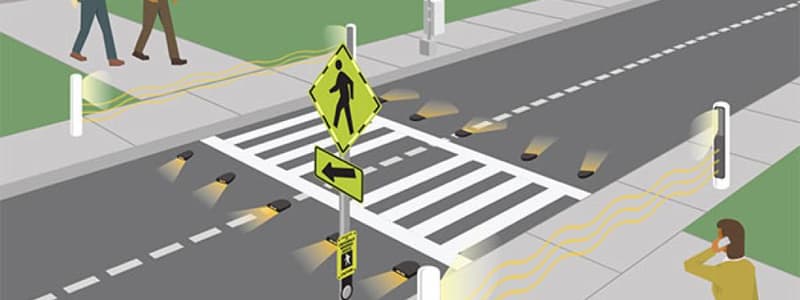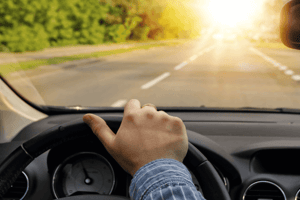Podcast
Questions and Answers
What should a pedestrian do when the DON'T WALK or Flashing Raised Hand signal is displayed?
What should a pedestrian do when the DON'T WALK or Flashing Raised Hand signal is displayed?
- Start crossing the street immediately
- Do not start crossing the street (correct)
- Wait for the signal to change to WALK before crossing
- Continue crossing the street if already started
What should a pedestrian do at a crossing with no pedestrian signals?
What should a pedestrian do at a crossing with no pedestrian signals?
- Cross the street whenever it is convenient
- Wait for a police officer to direct traffic before crossing
- Obey the vehicle traffic signals (correct)
- Ignore the vehicle traffic signals and cross when ready
How can blind or visually impaired pedestrians be assisted when crossing the street?
How can blind or visually impaired pedestrians be assisted when crossing the street?
- Verbal messages and sounds like beeping or chirping (correct)
- Holding the arm of a sighted person
- Flashing lights on the traffic signals
- Crossing the street only when the WALK signal is displayed
What should a pedestrian do at a STOP sign?
What should a pedestrian do at a STOP sign?
What type of crosswalk allows pedestrians to cross the intersection in any direction at the same time?
What type of crosswalk allows pedestrians to cross the intersection in any direction at the same time?
What is the main purpose of a crosswalk?
What is the main purpose of a crosswalk?
How should drivers approach a crosswalk with flashing lights?
How should drivers approach a crosswalk with flashing lights?
What should drivers do when approaching a blind pedestrian using a guide dog or white cane?
What should drivers do when approaching a blind pedestrian using a guide dog or white cane?
What should a driver do if they encounter another vehicle on a steep, narrow mountain road?
What should a driver do if they encounter another vehicle on a steep, narrow mountain road?
When should a driver honk their horn at a blind pedestrian?
When should a driver honk their horn at a blind pedestrian?
What should a driver do when approaching a roundabout?
What should a driver do when approaching a roundabout?
Which of the following is considered a vulnerable road user?
Which of the following is considered a vulnerable road user?
How should a driver interact with pedestrians at crosswalks?
How should a driver interact with pedestrians at crosswalks?
What is the correct behavior when a pedestrian makes eye contact at a crossing?
What is the correct behavior when a pedestrian makes eye contact at a crossing?
What is the recommended action if a driver misses their exit in a roundabout?
What is the recommended action if a driver misses their exit in a roundabout?
When driving at night, you should use your high-beam headlights in which of the following situations?
When driving at night, you should use your high-beam headlights in which of the following situations?
What should you do if another vehicle's lights are too bright and blinding you?
What should you do if another vehicle's lights are too bright and blinding you?
When should you check your blind spots?
When should you check your blind spots?
How should you check your blind spots?
How should you check your blind spots?
When should you check traffic behind you using your rearview mirror, side mirrors, and turning your head?
When should you check traffic behind you using your rearview mirror, side mirrors, and turning your head?
Flashcards are hidden until you start studying
Study Notes
Pedestrian Safety
- Always yield to pedestrians and allow them enough time to cross the road safely, especially seniors, people with small children, and people with disabilities who may require extra time.
- Pedestrians have the right-of-way in marked or unmarked crosswalks.
- Be cautious when approaching crosswalks, especially those with flashing lights, and look for pedestrians before turning or backing up.
- Never stop in the middle of a crosswalk, as this could force a blind pedestrian to walk into traffic outside of the crosswalk.
- Do not honk your horn at a blind person; instead, wait for them to pull in their cane and step away from the intersection before proceeding.
Crosswalks and Signs
- Crosswalks are marked with white lines, and school crossings may have yellow lines.
- Stop at the limit line before a crosswalk and allow pedestrians to cross the street.
- Obey all warning signs, regardless of their shape or color, and make a full stop before entering a crosswalk or intersection.
- Watch for signs and lane markings that guide you.
Special Pedestrians
- Pedestrians who are blind or visually impaired have the right-of-way at all times, and may use guide dogs or white canes.
- Be careful when turning or backing up, especially when driving a hybrid or electric vehicle, as these pedestrians rely on sound to know there is a vehicle nearby.
Roundabouts
- Travel in a counter-clockwise direction in a roundabout, and do not stop or pass.
- Signal when changing lanes or exiting, and choose your entry or exit lane based on your destination.
- If you miss your exit, continue around until you return to your exit.
Pedestrian Rules
- Pedestrians, including those with disabilities, must follow the rules of the road.
- When a pedestrian is crossing a roadway with or without a crosswalk, use caution, reduce your speed, or stop to allow them to safely finish crossing.
Blind Spots and Rear Visibility
- Check your blind spots before changing lanes, turning, merging, backing up, or leaving a parking space.
- Use your rearview mirror, side mirrors, and turn your head to check your blind spots.
- Know what is behind you to avoid rear-end collisions.
Road Conditions
- Use high-beam headlights on open country roads or dark city streets at night, but dim them to avoid blinding oncoming drivers.
- Be aware of your surroundings and adjust your speed according to road conditions.
- If another vehicle's lights are too bright, do not look directly into the headlights, but instead look toward the right edge of your lane and watch the oncoming vehicle out of the corner of your eye.
Studying That Suits You
Use AI to generate personalized quizzes and flashcards to suit your learning preferences.




